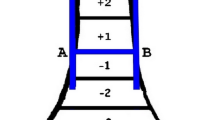Abstract
Purpose
Loss of pin fixation in supracondylar fractures can occur with failure to achieve bicortical fixation. Bicortical fixation may be challenging for those pins that attempt to penetrate the diaphyseal cortex, where the bone is thick. Lateral-entry Steinmann pins may allow for better penetration through cortical bone because they are more rigid than typical Kirschner wires.
Methods
A retrospective review of 16 children with type III supracondylar fractures treated by a single surgeon using Steinmann pins was undertaken. The average age at presentation was 6 years. Following closed reduction, all fractures were maintained with three lateral-entry pins. At least one Steinmann pin was placed in the lateral column of the distal humerus in each pin construct.
Results
Follow-up radiographs indicated a mean Baumann’s angle of 72.9° (range 64°–82°). There was no statistically significant change in the Baumann’s angle or axial alignment at final follow-up. All but one fracture healed in an anatomic position on the lateral view.
Conclusions
Steinmann pins placed through a lateral-entry point are effective in controlling the reduction of high-grade supracondylar fractures. The fixation is excellent and avoids potential ulnar nerve complications of medial entry.



Similar content being viewed by others
References
Blount WP (1955) Fractures in children. Williams & Wilkins, Baltimore, p 26
Omid R, Choi PD, Skaggs DL (2008) Supracondylar humeral fractures in children. J Bone Joint Surg Am 90:1121–1132
Sankar WN, Hebela NM, Skaggs DL, Flynn JM (2007) Loss of pin fixation in displaced supracondylar humeral fractures in children: causes and prevention. J Bone Joint Surg 89:713–717
Srikumaran U, Tan E, Erkula G, Bahk MS, Leet AI, Sargent MC, Ain MC, Sponseller PD (2009) Percutaneous pinning of pediatric supracondylar humerus fractures: does pin size matter? Paper poster #18, Pediatric Orthopaedic Society of North America, 2009 Annual Meeting
Kocher MS, Kasser JR, Waters PM, Bae D, Snyder BD, Kresko MT et al (2007) Lateral entry compared with medial and lateral entry pin fixation for completely displaced supracondylar humeral fractures in children. A randomized clinical trial. J Bone Joint Surg Am 89:706–712
Gordon JE, Patton CM, Luhmann SJ, Bassett GS, Schoenecker PL (2001) Fracture stability after pinning of displaced supracondylar distal humerus fractures in children. J Pediatr Orthop 21:313–318
Leitch KK, Kay RM, Femino JD, Tolo VT, Storer SK, Skaggs DL (2006) Treatment of multidirectionally unstable supracondylar humeral fractures in children. A modified Gartland type-IV fracture. J Bone Joint Surg Am 88:980–985
Flynn JC, Matthews JG, Benoit RL (1974) Blind pinning of displaced supracondylar fractures of the humerus in children. Sixteen years’ experience with long-term follow-up. J Bone Joint Surg Am 56:263–272
Williamson DM, Coates CJ, Miller RK, Cole WG (1992) Normal characteristics of the Baumann (humerocapitellar) angle: an aid in assessment of supracondylar fractures. J Pediatr Orthop 12(5):636–639
Herman MJ, Boardman MJ, Hoover JR, Chafetz RS (2009) Relationship of the anterior humeral line to the capitellar ossific nucleus: variability with age. J Bone Joint Surg Am 91(9):2188–2193
Skaggs DL, Cluck MW, Mostofi A, Flynn JM, Kay RM (2004) Lateral-entry pin fixation in the management of supracondylar fractures in children. J Bone Joint Surg Am 86:702–707
Diederichs G, Issever AS, Greiner S, Linke B, Korner J (2009) Three-dimensional distribution of trabecular bone density and cortical thickness in the distal humerus. J Shoulder Elbow Surg 18(3):399–407
Acknowledgments
The authors would like to thank E. O’Brian Smith, PhD (Texas Children’s Hospital, Houston, Texas) for his assistance with the statistical analysis.The authors have no financial relationship with the organization that sponsored the research. The authors have full control of the primary data and allow the journal to review the data, if requested.
Author information
Authors and Affiliations
Corresponding author
About this article
Cite this article
Weinberg, J., Belthur, M.V. The role of lateral-entry Steinmann pins in the treatment of pediatric supracondylar humerus fractures. J Child Orthop 4, 455–459 (2010). https://doi.org/10.1007/s11832-010-0283-5
Received:
Accepted:
Published:
Issue Date:
DOI: https://doi.org/10.1007/s11832-010-0283-5




